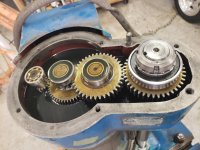At a glance...this appears to be an M40 Acme thread with a 7MM pitch.
I counted 5 threads within a .950" span. Is that a 7MM pitch? The OD of the shaft is 1.580" which is pretty close to 40MM.
McMaster actually sells new nuts...I haven't measured every dimension but I bet they would work with some lathe time. But....$236 each.
I heated the nut up to about 325F using a MAPP torch. Then I sprayed more Kroil down the threads. Then after it cooled a bit I repeated it.
I'll probably reassemble it enough to let me put torque back on the shaft to see if/how it has freed up. Later, once I gain some enthusiasm back. Right now it's just another oily slop-mess.
I counted 5 threads within a .950" span. Is that a 7MM pitch? The OD of the shaft is 1.580" which is pretty close to 40MM.
McMaster actually sells new nuts...I haven't measured every dimension but I bet they would work with some lathe time. But....$236 each.
I heated the nut up to about 325F using a MAPP torch. Then I sprayed more Kroil down the threads. Then after it cooled a bit I repeated it.
I'll probably reassemble it enough to let me put torque back on the shaft to see if/how it has freed up. Later, once I gain some enthusiasm back. Right now it's just another oily slop-mess.







